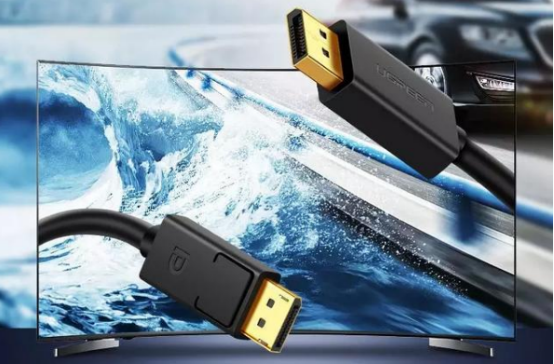Which is better, the video DP interface or the HDMI interface?
In the intelligent weak current project, when we deal with the connection of video images, the two interfaces we often use are the DP interface and the HDMI interface. Today we will compare these two interfaces.
DisplayPort, abbreviated as DP, is a digital video interface standard developed by the PC and chip manufacturer alliance and standardized by the Video Electronics Standards Association (VESA). This interface is free of authentication and authorization, and is mainly used for connecting video sources to displays and other devices. It also supports carrying audio, USB, and other forms of data.
This interface is designed to replace the traditional VGA, DVI and FPD-Link interfaces. Through active or passive adapters, the interface is backward compatible with traditional interfaces (such as HDMI and DVI).
It is a digital high-definition interface with the current mainstream HDMI interface. Both support one signal line to transmit video and audio signals at the same time. The DP interface has reached 10.8Gbps bandwidth from the first generation and supports 2560 x 1600 12bit output. At present, the most widely used DP1.2 on the market has reached 21.6Gbit / s, surpassing HDMI2.0, supporting 1080P 240, 2K 165, 4K 75, 5K 30. DP1.3 supports 2K 240, 4K 120, 8K 30.
The latest DP1.4 support is basically the same, with a bandwidth of up to 32.4Gbps, but the DSC display compressed streaming technology is added to support 4K and 8K. In addition, HDR data packets, forward error correction, 32-channel 1536KHz and other technologies are supported.

Advantages: AMD multi-screen splicing technology must have a DisplayPort interface. Higher bandwidth and lower cost. Dp interface can easily support such super high resolution display as 2560 × 1600. At the same resolution, DP responds faster, and the resolution supported by DP is higher. Due to the limited bandwidth of HDMI, only 30 frames of image can be transmitted per unit time, and DP does not have this limitation. Therefore, at high resolution (above 3840 * 2160), the DP interface is better. Not much difference.
The difference between HDMI and DP lies in the number of frames transmitted in a unit of time. HDMI can only transmit up to 30 frames, while DP is unlimited. Free. The latest DisplayPort interface is not like the HDMI interface. It needs to pay a certain amount of membership fees every year. It is not necessary to pay for every product with an HDMI interface like the HDMI interface. It is completely royalty-free in the true sense. The DP interface is only popular in the PC field and high-end displays, and the transmission distance of the DP line is generally stable transmission at about 10 meters.
HDMI is currently the most mainstream high-definition interface, the full name is "high-definition multimedia interface", can support video and audio, if your display has a sound, you can achieve audio transmission, such as LCD TVs and some speakers that support sound, features It supports high resolution, small interface, uncompressed audio streaming, and rich protocols. The current mainstream HDMI 1.4 theory supports 1080P 144hz, 2K 75hz, 3840 x 2160 / 30hz, 4096 x 2160 / 24hz. HDMI2.0 has a bandwidth of up to 18Gbps and supports 1080P 240hz, 2K 144hz, 4K 60hz, and 5K 30hz.
The latest HDMI2.1 can support 2K 240hz, 4K 144hz, 5K 60hz, 8K 30hz. Advantages: There are many types of devices that support the HDMI interface. In terms of popularity, it can be said that the HDMI interface has an absolute advantage. In daily life, the HDMI interface is obviously more than the DP interface. It dominates most display devices such as TVs and projectors. Set-top boxes used in homes are also commonly used. Interface, in addition, the current well-known game console platforms have adopted the HDMI interface as a line transmission method.
So from the above we can see the difference between the two Different technical support: AMD multi-screen splicing technology must have a Display Port interface. Users need to connect to the display device that supports this interface through the DisplayPort data cable to become the main display of the three-screen splicing display, and must be directly connected by the DisplayPort interface, and cannot undergo any form of conversion.
Different bandwidth support: HDMI 2.1 performance is very close to DP1.4 in terms of performance, but HDMI 2.1 surpasses DP 1.4 in bandwidth and data rate, resolution, refresh rate, and supports more video specifications than DP , But if HDMI 2.1 is not fully popular, you can use the DP interface.
The production cost of the manufacturers is different: the DP interface technology is free. The DisplayPort interface is not like the HDMI interface. It needs to pay a certain amount of membership fees every year. It is not necessary to pay for each product that contains the HDMI interface like the HDMI interface. Full royalty-free in the sense. Therefore, the DisplayPort interface has been strongly supported by many internationally renowned manufacturers.
If you want to know more, our website has product specifications for interface, you can go to ALLICDATA ELECTRONICS LIMITED to get more information

